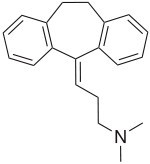Amitriptyline/perphenazine
 | |
 | |
| Combination of | |
|---|---|
| Amitriptyline | Tricyclic antidepressant |
| Perphenazine | Typical antipsychotic |
| Clinical data | |
| Trade names | Duo-Vil, Etrafon, Triavil, Triptafen |
| AHFS/Drugs.com | Consumer Drug Information |
| License data | |
| Pregnancy category |
|
| Routes of administration | Oral |
| Legal status | |
| Legal status |
|
| Identifiers | |
| CAS Number | 8015-22-3 |
Amitriptyline/perphenazine (Duo-Vil, Etrafon, Triavil, Triptafen) is a formulation that contains the tricyclic antidepressant amitriptyline and the medium-potency typical (first-generation) antipsychotic, perphenazine. In the United States amitriptyline/perphenazine is marketed by Mylan Pharmaceuticals Inc. and Remedy Repack Inc.[1][2]
Medical uses
In the United States amitriptyline/perphenazine is indicated for the treatment of patients with:[1][2][3]
- Moderate-severe anxiety and/or agitation and depression
- Depression and anxiety in association with chronic physical disease
- Schizophrenia with prominent depressive symptoms
Adverse effects
- Sedation
- Hypertension — high blood pressure.
- Neurological impairments (such as extrapyramidal side effects which include dystonia, akathisia, parkinsonism, muscle rigidity, etc.)
- Anticholinergic side effects such as:
- - Blurred vision
- - Constipation
- - Dry mouth
- - Nasal congestion
- Increased appetite
- Weight gain
- Nausea
- Dizziness
- Headache
- Vomiting
- Diarrhoea
- Alopecia — hair loss
- Photophobia
- Pigmentation
- Eczema up to exfoliative dermatitis
- Urticaria
- Erythema
- Itching
- Photosensitivity (increased sensitivity of affected skin to sunlight)
- Hypersalivation — excessive salivation.
- Hyperprolactinaemia — elevated blood prolactin levels. This may present with the following symptoms:
- - Galactorrhea — the release of milk that is not associated with pregnancy of breastfeeding
- - Gynaecomastia — the development of breast tissue in males
- - Disturbances in menstrual cycle
- - Sexual dysfunction
- Pigmentation of the cornea and lens
- Hyperglycaemia — elevated blood glucose (sugar) levels.
- Hypoglycaemia — low blood glucose (sugar) levels.
- Disturbed concentration
- Excitement
- Anxiety
- Insomnia
- Restlessness
- Nightmares
- Weakness
- Fatigue
- Diaphoresis — excessive/abnormal sweating.
- Tardive dyskinesia, an often irreversible adverse effect that usually results from chronic use antipsychotic medications, especially the high-potency first-generation antipsychotics. It is characterised by slow (hence tardive), involuntary, repetitive, purposeless muscle movements.
- Neuroleptic malignant syndrome, a potentially fatal complication of antipsychotic drug use. It is characterised by the following symptoms:
- - Muscle rigidity
- - Tremors
- - Mental status change (e.g. hallucinations, agitation, stupor, confusion, etc.)
- - Hyperthermia — elevated body temperature
- - Autonomic instability (e.g. tachycardia, high blood pressure, diaphoresis, diarrhoea, etc.)
- Urinary retention — the inability to pass urine despite having urine to pass.
- Blood dyscrasias e.g. agranulocytosis (a potentially fatal drop in white blood cell count), leukopaenia (a drop in white blood cell counts but not to as extreme an extent as agranulocytosis), neutropaenia (a drop in neutrophil [the cells of the immune system that specifically destroy bacteria] count), thrombocytopaenia (a dangerous drop in platelet [a cell found in the blood that plays a crucial role in the blood clotting process] counts), purpura (the appearance of red or purple discolourations of the skin that do not blanch when pressure is applied), eosinophilia (raised eosinophil [the cells of the immune system that specifically fights off parasites] count)
- Hepatitis — inflammation of the liver
- Jaundice
- Pigmentary retinopathy
- Anaphylactoid reactions
- Oedema — the abnormal buildup of fluids in the tissues
- Asthma
- Coma
- Seizures
- Confusional states
- Disorientation
- Incoordination
- Ataxia
- Tremors
- Peripheral neuropathy — nerve damage
- Numbness, tingling and paresthesias of the extremities
- Dysarthria
- Syndrome of inappropriate antidiuretic hormone secretion (SIADH)
- Tinnitus — falsely hearing ringing in the ears.
- Alteration in EEG patterns
- Paralytic ileus — cessation of the peristaltic waves that propel partially digested food through the digestive tract.
- Hyperpyrexia (elevated body temperature)
- Disturbance of accommodation
- Increased intraocular pressure
- Mydriasis
Pharmacology
Binding affinities (Ki[nM]; for human cloned receptors when available)[5][6][7]
| Macromolecule | Amitriptyline | Nortriptyline (Amitriptyline's active metabolite) | Perphenazine | Notes |
|---|---|---|---|---|
| SERT | 3.13 | 16.5 | ? | It is this and its NET-inhibiting action is believed to give amitriptyline its antidepressant action. |
| NET | 22.4 | 4.37 | ? | See above. |
| DAT | 5380 | 3100 | ? | |
| 5-HT1A | 450 | 294 | 421 | Binding for human brain receptors had to be substituted in amitriptyline (AMI) and nortriptyline's (NOR) cases |
| 5-HT2A | 4.3 | 5 | 5.6 | Binding for cloned rat receptors had to be substituted for AMI & NOR. Binding to this receptor is believed to be what gives the newer (atypical) antipsychotics, clozapine, quetiapine, olanzapine, ziprasidone, risperidone, sertindole and zotepine their lower extrapyramidal side effect (EPS) liability. |
| 5-HT2C | 6.15 | 8.5 | 132 | (Binding) As above. This action is believed to be partly responsible for the lower EPS liability of newer antipsychotics and also responsible for their higher weight gain liability compared to most typical antipsychotics. |
| 5-HT6 | 103 | 148 | 17 | Cloned rat receptor was substituted for NOR's binding. |
| 5-HT7 | 114 | ? | 23 | Cloned rat receptor was substituted for AMI. |
| α1A | 24 | 55 | 10 | Human brain receptors were substituted for AMI and NOR. |
| α2A | 690 | 2030 | 810.5 | As above. |
| D2 | 1460 | 2570 | 0.16 | As above. |
| D3 | 206 | ? | 0.13 | Human receptors (their source was undefined) had to be substituted for AMI. |
| H1 | 1.1 | 15.1 | 8 | This receptor is at least partly responsible for the sedating effects of these three drugs and hence this combination product. Possibly also partly responsible for their weight gain liability. |
| M1 | 12.9 | 40 | 1500 | This is the main receptor responsible for the anticholinergic side effects mentioned above. |
| M3 | 25.9 | 50 | 1848 | This receptor is believed to be partly responsible for the metabolic adverse effects of the atypical antipsychotics. |
| σ | 300 | 2000 | 31.5 | All three values are for binding to the guinea pig brain receptors. |
See also
References
- 1 2 3 4 5 "PERPHENAZINE AND AMITRIPTYLINE HYDROCHLORIDE tablet, film coated [Mylan Pharmaceuticals Inc.]". DailyMed. National Library of Medicine. Retrieved 7 October 2013.
- 1 2 3 4 5 "PERPHENAZINE AND AMITRIPTYLINE HYDROCHLORIDE tablet [REMEDYREPACK INC. ]". DailyMed. National Library of Medicine. Retrieved 7 October 2013.
- ↑ amitriptyline/perphenazine (Rx) - Etrafon, Triptafen, Triavil [Internet]. Medscape Reference. [cited 2013 Oct 7]. Available from: http://reference.medscape.com/drug/etrafon-triptafen-amitriptyline-perphenazine-342946
- 1 2 3 Truven Health Analytics, Inc. DRUGDEX® System (Internet) [cited 2013 Oct 7]. Greenwood Village, CO: Thomsen Healthcare; 2013.
- ↑ National Institute of Mental Health. PDSD Ki Database (Internet) [cited 2013 Oct 7]. Chapel Hill (NC): University of North Carolina. 1998-2013. Available from: "Archived copy". Archived from the original on 2013-11-08. Retrieved 2013-12-01.
- ↑ Brunton L, Chabner B, Knollman B. Goodman and Gilman’s The Pharmacological Basis of Therapeutics, Twelfth Edition. McGraw Hill Professional; 2010.
- ↑ Taylor D, Paton C, Kapur S, Taylor D. The Maudsley prescribing guidelines in psychiatry. 11th ed. Chichester, West Sussex: John Wiley & Sons; 2012.
This article is issued from Wikipedia - version of the 10/11/2016. The text is available under the Creative Commons Attribution/Share Alike but additional terms may apply for the media files.